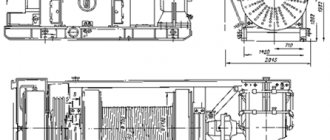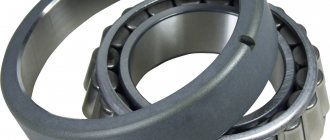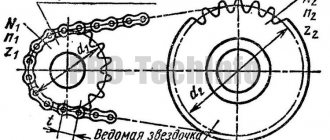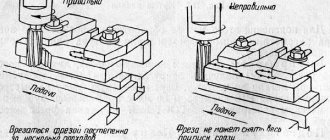To penetrate hard rocks when drilling wells, bits are used. Depending on the design, three types can be distinguished:
- bladed augers;
- bladed for drilling with flushing/purging;
- roller cone.
Different designs also imply different purposes for the cutting elements. At the same time, all types of drill bits are used for rotary drilling; If it is necessary to impact the rock, it is worth using other destructive elements.
Auger drill bits
Blade auger bits are used as a rock cutting tool for rotary auger drilling.
The design of these tools allows for the possibility of being reinforced with one of four types of hard alloy surfacing:
- plates (including reinforced ones);
- carbide teeth;
- carbide pins;
- flat incisors.
Depending on the purpose of the drill bit, surfacing can be combined. Thus, sufficient strength is achieved for drilling rocks up to category V in terms of drillability, inclusive.
The assortment of Geomash JSC includes two- and three-bladed bits with a diameter from 75 to 530 mm. This allows you to choose the right tool for working in different conditions.
The connection to the screw column is made using triangular or hexagonal connections.
Drilling work with a roller bit
This type of bit is caused by chipping and crushing rock. This device is intended for drilling wells for the purpose of gas or oil production. The equipment looks like this: a complex type combination with rotating teeth of different sizes.
Roller-type bits are used for drilling operations of all levels of rock hardness. Thanks to this universal property, they are widely used. It is impossible to do such an installation with your own hands; it is recommended to purchase one.
This equipment contains a rotary drilling tool with quarry machines and a cutter, which has teeth of various lengths and configurations. Carbide-based pins can be pressed into it. Tungsten carbide (from which the teeth are made) is capable of breaking down any rock, from the softest to the hardest.
The roller bit is used for drilling:
- exploration wells;
- operational;
- search engines;
- exploration;
- geotechnical engineering, etc.
Diagram of a single-cone bit/
In terms of technology and design, this equipment is difficult to manufacture. They come in one, two, three or four cones.
Features of design parameters:
- The axis of the cutters and their tops are relative to the axis of the bit.
- The angle of inclination of the roller cutter axis is determined by the axis of the device.
- The number of cones on the roller cutters.
- Location of the ring teeth.
- The originality of the geometric parameters of the bit elements.
This type of equipment is applicable to drilling exploration wells and blasting wells. It is especially necessary for the destruction of hard rocks. The invention of a chisel with cone-shaped cutters belongs to the USA.
A roller-type drill bit is considered an integral element of drilling operations. It became popular in Russia due to the fast and efficient drilling of oil and gas wells.
With the help of cutters, which are made of hard steel or alloy, strong rocks are destroyed. They rotate, mounted on the bit supports, and the equipment itself rotates along with them, pressing against the bottom.
A core drill bit can consist of many cutters of different shapes. The rock destruction element is teeth made of alloyed steel or milled teeth. Their combination contributes to the effective destruction of any rock. To increase the resistance of the cutters to all kinds of damage, they are filled with a tungsten carbide alloy. The shape and parameters of this equipment (point angle, length and arrangement of teeth) depend on the properties of the rock. For drilling operations, teeth with a wedge-shaped cone are used.
To break up hard rock, supports are used in the bit's design. Sealing supports is necessary for complex work.
Roller bits come in solid-body and sectional designs. The first type of chisel is characterized by welding the paws with cutters, the second - by welding a separate section.
Blade drill bits
This tool is used when drilling wells in rocks up to category V in terms of drillability using drilling fluid or air as a cleaning agent. The most common are three-blade models, which provide high penetration rates. If you have to deal with rocks of categories VI - V, then it is recommended to use chisels with four or six blades.
To reduce the abrasive effect on the tool design, carbide surfacing is provided. In addition, to increase the duration of use, it is possible to quickly replace the cutting teeth.
The line of tools produced by Geomash JSC includes blade-type drill bits with an outer diameter from 112 to 295 mm. Also, when choosing, you should take into account the diameter of the connection. If the rock cutting tool and the drill rod have different threads, you will have to use an adapter or, if this is not possible, buy a suitable bit.
Common types
When choosing a chisel, not everyone understands what it is. Even realizing that these are different tools that are united by the chiselling process, to make the right choice you need to evaluate a number of characteristics. The types differ in structure, purpose and operating characteristics.
Carpentry
Models are used to create nests and grooves in wooden surfaces. The width of the working part is rarely more than 1.5 cm. A carpenter's chisel is suitable for cleaning window frames or processing furniture parts. Using a narrow blade, they cut locks into doors.
Types of chisels Source otpravka.com.ua
The model is easy to recognize by the structure of its working elements. The long, thin steel blade has a noticeable bevel on the edge, so the tool has excellent sharpening. The rectangular shape of the tip helps to carry out accurate actions, knocking out remaining wood from grooves and holes. Varieties with a semicircular nozzle are used for cutting grooves and cleaning corners.
Carpentry
Visually, the model resembles a carpentry structure, but of larger dimensions. The tool is used when processing wood from log houses or floors. The dense working part turns into a square or rectangular blade. The wide nozzle provides a secure grip and safety for the user.
Security measures
When carrying out joinery and carpentry work using the gouging method, it is necessary to pay attention to the condition of the equipment used . After all, the better the working surface is sharpened, the smoother the processed surface will be. To avoid injury when gouging holes, pay attention to the integrity of the tool handle and the striking part of the mallet.
There should be no chips or cracks. The workpiece must be securely fastened . The direction of work should be away from you.
A chisel is a tool with a narrow focus, so it is highly undesirable to use it for other purposes.
Terms of use
Before starting work, the chisel is sharpened. This is done on an emery wheel. The sharpening angle should be 20-25 degrees. The sharpening itself should be as smooth as possible, the cutting edge should not have any distortions, even a slight distortion of 3-4 degrees will affect the final result and the quality of the workpiece.
Working with a chisel is not difficult; a little training is enough to learn how to use it correctly. The process is carried out as follows:
- The workpiece is marked with a pencil and securely fastened;
- The blade is placed along the marked line so that the rod has a vertical position;
- The first blow of the mallet on the handle should be light - with its help, a small indentation is made.
- The second blow is applied harder - the tip should enter the workpiece 4-5 mm.
- After that, it is removed from the array and installed nearby. The next blow is delivered. The process is repeated.
- After a closed contour is formed, the top layer of wood 3-5 mm is removed using a chisel.
- The remaining layers are removed using a different method - here it is placed at an angle of 30-45 degrees to the horizontal surface and the wood is removed along the grain. With light blows the wood is hollowed out from the solid wood.
Security measures
The first rule of safe work requires that the blade be well sharpened. If you use a blunt tool, there is a danger of injuring yourself by applying excessive force in the work.
The second rule requires that the workpiece itself be correctly fixed when working. Rigid fixation will ensure high quality work and no injuries.
The third rule is that the rod and handle itself should not have chips, cracks or burrs. The handle must have a ring.
Knowing about these properties of the tool, in the future it will be easy to master the techniques of working with it and make the correct selection of the chisel by type and size.
Manufacturers
When choosing carpentry tools, it is important to pay attention to the manufacturer’s brand. There are several brands that have proven themselves to be the best. Among them are the following.
- "Anchor". This manufacturer produces sets of chisels that are perfect for beginners. The handle of the tool is wooden, the blade is made of durable alloy steel, which increases the service life of the chisel. The sets contain tools of different sizes, among which you can choose a chisel for any type of work. This manufacturer also has a very attractive price for its product.
- Stanley. Chisels from this manufacturer are designed for fine woodworking. This tool has a two-component handle, the blade is made of durable high-carbon steel. Therefore, this tool can be used to process even the most durable types of wood.
- Matrix. This manufacturer produces chisels and chisels for deep wood processing, thanks to long blades. The handle of these tools is usually rubber, but extremely durable, which allows you to strike the chisel with a mallet without fear of damaging it.
- Narex. Experienced carpenters use tools from this manufacturer. The cost of such chisels is higher than that of other brands, but these tools are highly reliable. The chisel blade does not become dull even with daily use.
Carpentry work
- Wood is simply a unique working material. Durable and lightweight. It is easy to process, and after that it retains heat and smell.
- Raw wood is plastic and perfectly takes the required shape during processing.
- High-quality carpentry will highlight the grain of the cut, so there is no need to paint the wood.
- To prevent the timber from losing its pattern during processing, you must first determine the direction of the fibers. A complete picture will be given by sawing the timber across and along the grain, at an angle of 45°.
Proper placement of the drawing on the timber will help you create a real masterpiece and emphasize the beauty of the texture pattern!
Description of the tool
To perform a number of works, both carpentry and carpentry, it is often necessary to make rectangular or square holes in solid wood. With round through or blind holes everything is clear - a drill and a drill of the required diameter are enough. But with such non-standard holes, a chisel is used - a tool designed for chiselling work.
Primitively, it can be imagined as a metal rod with one sharply sharpened end. But this is only a schematic representation; in fact, the chisel looks a little different, its rod has a complex shape, with a sharpened blade and a powerful wooden handle. At the base of the structure lies a rectangular or square steel bar. The working edge is a beveled edge at an angle of 25-30 degrees. The other end usually takes the shape of a pike during forging - a wooden handle is put on it. A solid wooden handle is made of hard wood, but given that it is the handle that will be hit by a mallet or hammer, the material chosen is durable and tough, such as beech or oak.
A carpenter's chisel can have a different blade size; its main difference from other tools is that the blade has the same cross-section along its entire length. This is due to the fact that it is used for rough processing of workpieces, while the main work consists of chiseling wood across the grain. It looks massive due to the large handle and blade. Its secret is the metal from which the blade is forged. It is difficult to make it at home without blacksmithing skills. The metal used must be durable, hold an edge for a long time and not be afraid of shock loads.
Advantages of rotary technology
What are the advantages of rotary drilling over possible alternatives? There are several of them.
Firstly, using a rotary bit, you can create large-diameter wells that can fully satisfy the water needs of several households at once.
It is no secret that drilling is not a cheap process: it requires specialized equipment, and experienced drillers must monitor and manage the process. After all, activities related to well drilling are licensed. Hence its high price.
Due to its shape and design, the bit during rotary drilling can form wells of a much larger diameter than auger drills and core pipe
Uniting several households at once to finance one common well for adjacent plots is an economically profitable enterprise. But this requires a significant debit. In most cases, aquifers of Quaternary sediments (sands) cannot provide them.
Naturally, for collective operation, it is better to install the water intake on limestone. The groundwater extracted from it is characterized by greater water abundance and purity. The volume of precipitation does not have the slightest influence on the flow rate of wells on limestone. The same cannot be said about sand wells.
Secondly, the relatively low energy costs are convincing. The working element in rotary drilling is the bit. But unlike auger and core drilling, the drilling tool does not interact with the walls of the drilled well
That is, only the bit is in direct contact with the ground, the height of which is negligible in relation to the height of the entire drill string. As a result, this method of forming wells is the fastest - up to 1000 linear meters per month!
Thirdly, collective customers are attracted by the drilling depth. Only with the rotary method can a well be drilled deep into bedrock metamorphic and igneous rocks, from the cracks of which water can be pumped, the composition of which is most suitable for drinking purposes.
Most often, only process water is extracted from water intake workings less than 30 m deep. Its composition is influenced by nearby reservoirs, rivers littered with garbage, precipitation, and simply technical fluids spilled on the ground. An auger and a core pipe will help to obtain only such a water intake.
The entire set of drilling equipment is easily mounted on a single medium-duty vehicle platform. This makes the rotary drilling process much more technologically advanced, and therefore cheaper
In addition, rotary drilling allows you to go through the workings to full depth without switching to another drilling method. When developing a well with an auger, for example, if it is necessary to drill through a boulder, they switch to the percussion rope method.
To do this, remove the auger from the barrel and throw the chisel at the face until the boulder is broken. Then the face is cleared with a bailer. It is also used if it is necessary to raise water-saturated sand to the surface, which simply cannot be retained in the core pipe.
Practice shows that wells drilled using the rotary method have a longer service life. Technologically, this is explained by the fact that after installing the casing that forms the walls of the well, the annulus is further strengthened.
Difference from a chisel
The difference between a chisel and a chisel lies in the specific application. The chisel is intended for rough work; its main purpose is to gouge out solid wood. This operation is carried out by hitting the handle with a hammer or mallet. A chisel is a thin tool; most operations are performed using manual force, and only certain operations are performed using a mallet or hammer.
A chisel and a chisel also have structural differences - the chisel resembles a chisel, it has a massive square-shaped blade, a powerful handle with a metal ring on the butt plate. The chisel has a thin blade; for finishing work, you do not need to additionally hit the butt plate with a hammer. The sharpened blade of a chisel is designed for cutting wood in small pieces, most often with just hand force.
Another difference is the shape of the blade and sharpening point. A chisel with the blade sharpened at an angle of 20-25 degrees is enough to make a through hole, a recess, or remove part of solid wood.
It is customary to use a chisel to fine-tune parts to the desired size. The chisels themselves are not only flat, they come with a semicircular blade and a beveled cutting edge. When sharpening, a carpenter's tool is usually sharpened using emery, but a carpenter's tool, after sharpening on emery, must be sharpened manually on a whetstone.
Tips for proper knife sharpening
| Sharpening tools has its secrets. Items such as knives, chisels and plow bits are best sharpened using a sharpening wheel. To carry out this operation, the knife must be applied to the middle of the circle with its tip. Be careful - there may be several options here. First: if you place the knife on the sharpening wheel, you will end up with a wide blade. Second: in a situation where your blade has serrations, you need to place the knife perpendicular to the circle. It will be useful to grind the knife blade in a circular motion immediately after sharpening. |
| The wide blade of the knife is advantageous in that it is easier to carry out frequent fine-tuning on it using a home manual sharpener, which is so convenient for housewives. |











